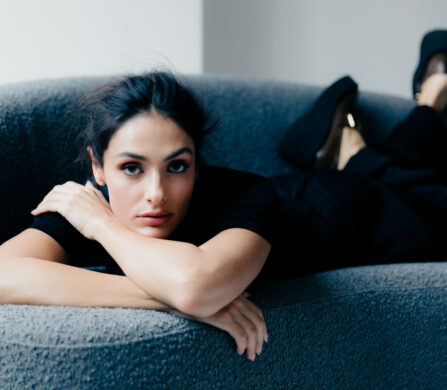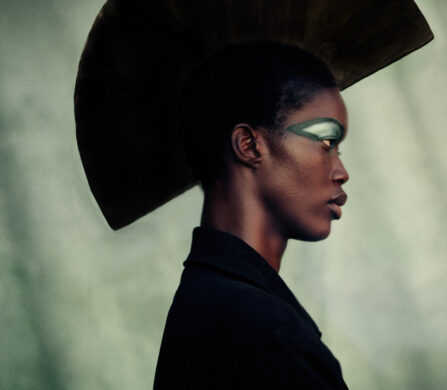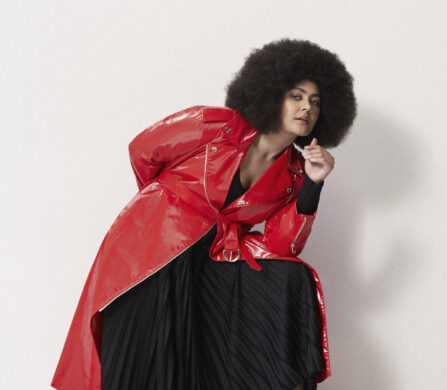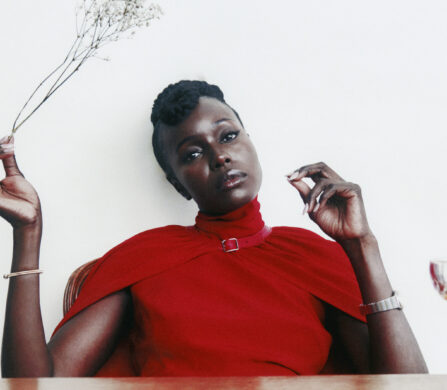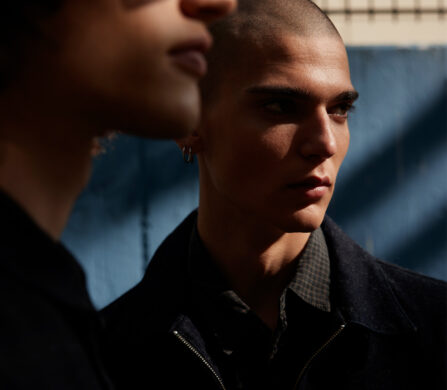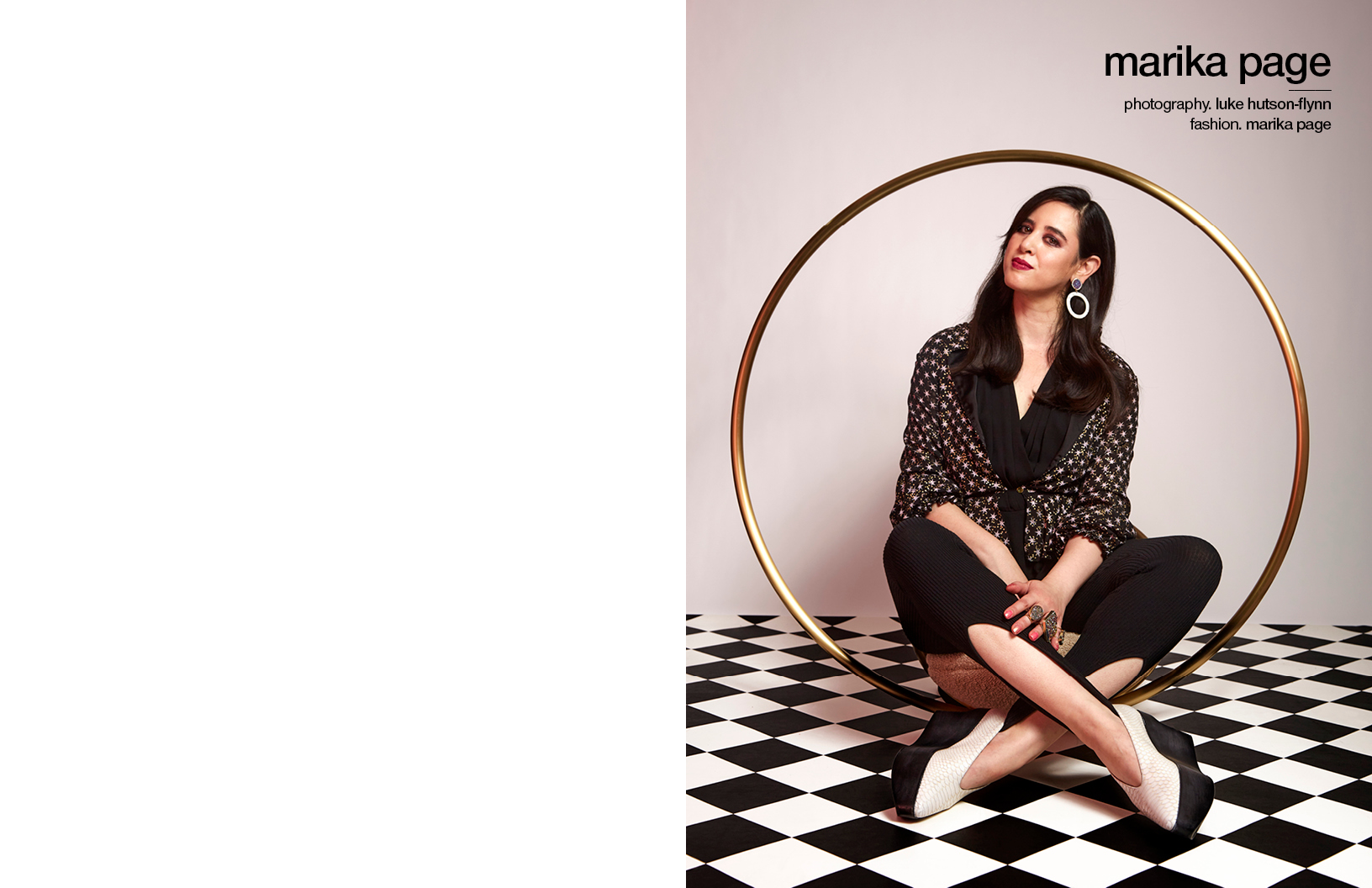
shirt. Stina Goya
top. Rebecca Taylor
leggings. Andrea Adamo
earrings. Baublebar
rings. Tiana Jewel “Divine Love Oval
Rainbow Metallic Ring”, “Steffy Rainbow
Metallic Square Ring”, “Divine Love Tear
Drop Statement Rainbow Metallic Ring”,
“Divine Love Tear Drop Rainbow Metallic
Ring”
shoes. Stella McCartney
chair. Lee Broom “Hanging Hoop Chair
Gold; Beige Boucle”
Understanding how to conflate the power of performance with everyday life, stylist Marika Page’s talent lies in giving all her ‘charges’ – from pop stars to private clients – the ability to truly own the room. Via intuitively crafted looks, it’s a dual-pronged process of reclamation and transformation born out of Greek-Filipino Page’s outsider status growing up in suburban 1980’s Melbourne, an enduring appreciation of the energy and escapism of club culture and an early submersion in show business.
“What I’ve always liked about styling is the ability to create who you are, a persona that allows you to get your power back,” states Page. The ethos was birthed in her early years growing up in the “Scott and Charlene [Neighbours]–era Australia” – a reference to two of terrestrial TV’s most iconic (pre-Netflix) stars, but a golden couple of a definitively blue-eyed blonde-haired Aussie archetype she certainly didn’t fit. Using fashion to create visibility, facilitating social mobility, as part and parcel of a highly personal sartorial vocabulary remains an intrinsic part of the Page mantra, but her perspective is far from based on backlash; the smoke and mirrors genius of TV, theatre and the formidable world of costuming have been equally critical to informing her (generally slightly maximalist) visual eye.
Until the age of sixteen she trained as a performer (singing and dancing) — attending a special after-school club that primed talented children for TV auditions, particularly a show called Young Talent Time, featuring Kylie and Dannii Minogue. She describes it as an environment in which she found solace from her shyness and bullying at primary school and the place where a first-hand understanding of how the confidence-cultivating armoury of costume took grip: “I’d go from one end of the spectrum to the other, from this shy kid to being quite ‘out there’, which continues now. I always want to deliver a sense of ‘I own this space’, to use fashion to present the person, the cool girl, that everyone watches when they walk into a club.”
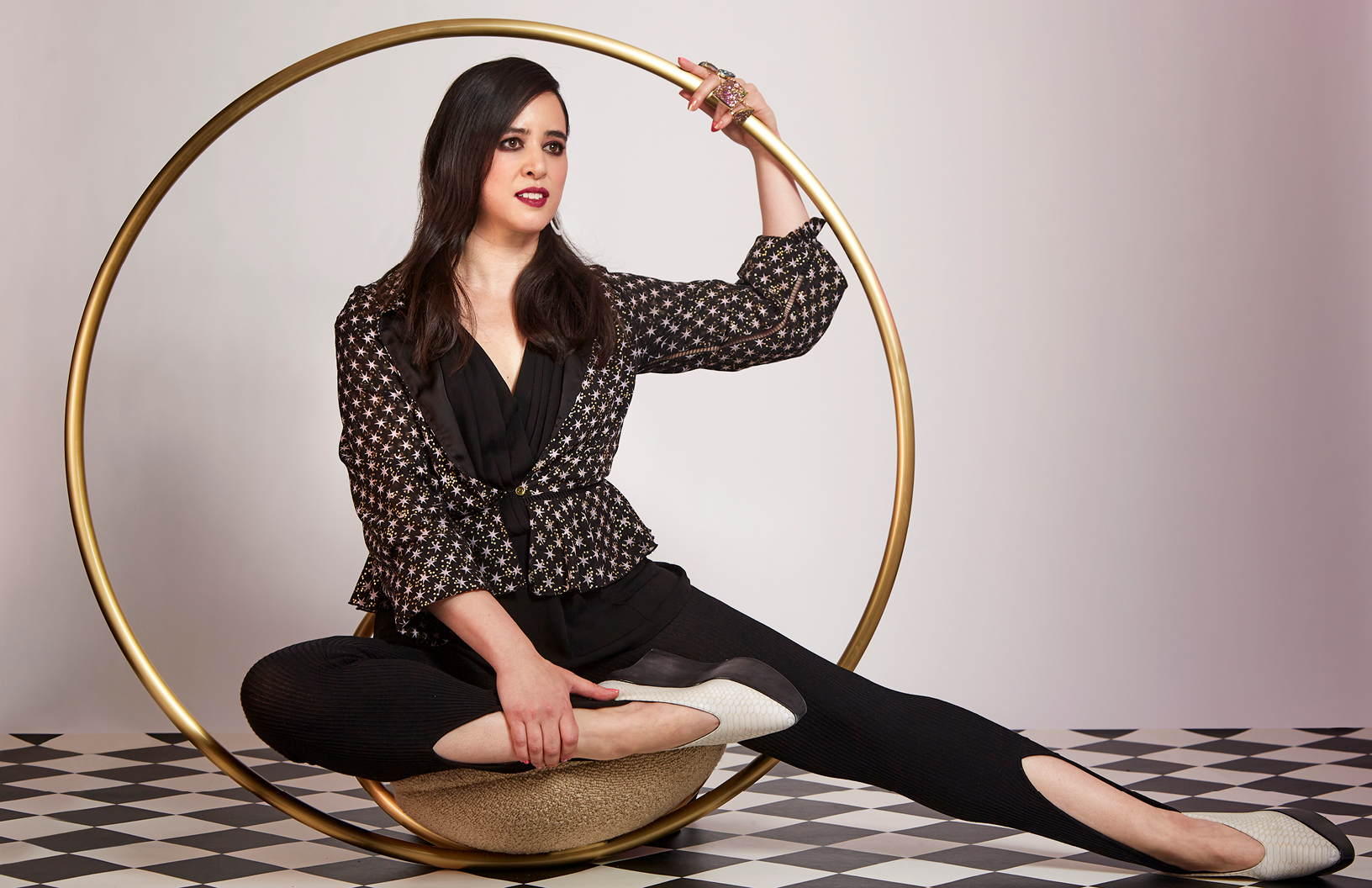
shirt. Stina Goya
top. Rebecca Taylor
leggings. Andrea Adamo
earrings. Baublebar
rings. Tiana Jewel “Divine Love Oval
Rainbow Metallic Ring”, “Steffy Rainbow
Metallic Square Ring”, “Divine Love Tear
Drop Statement Rainbow Metallic Ring”,
“Divine Love Tear Drop Rainbow Metallic
Ring”
shoes. Stella McCartney
chair. Lee Broom “Hanging Hoop Chair
Gold; Beige Boucle”
That appetite for “the escapism of arts and culture” underscores Page’s creative vision, but it wasn’t until her early thirties when she moved from Australia to London via a European holiday (aged twenty-nine) that it morphed into a full-time occupation. Prior to professional styling she’d undertaken an MA in creative writing and pursued a successful but ultimately doomed career in law, which continued until she was thirty-four: “It was ridiculous; by the end I was so obsessed with styling that I was taking meetings with singers and musicians in the [lawyers’] offices”.
She describes the intervening (pre pro-stylist) years, both as a lawyer and a student, not as a creative wasteland, but as fundamental to building a back catalogue of cultural references and inspiration that she still summons mentally for any new project, big or small: “I’d go to clubs a lot and was heavily influenced by the idea of using fashion as a way of transplanting yourself to a more aspirational space. I’d even plan my holidays around them, such as Gallery in LA – an indoor/outdoor venue that doesn’t even look safe or legal but had this incredible after-party venue vibe and characters. I don’t consider myself a cerebral stylist, it’s all about instinct and pulling on my past sentiments and visual recollections. Law was about disconnecting with your emotions on lots of levels, whereas fashion is the opposite.”
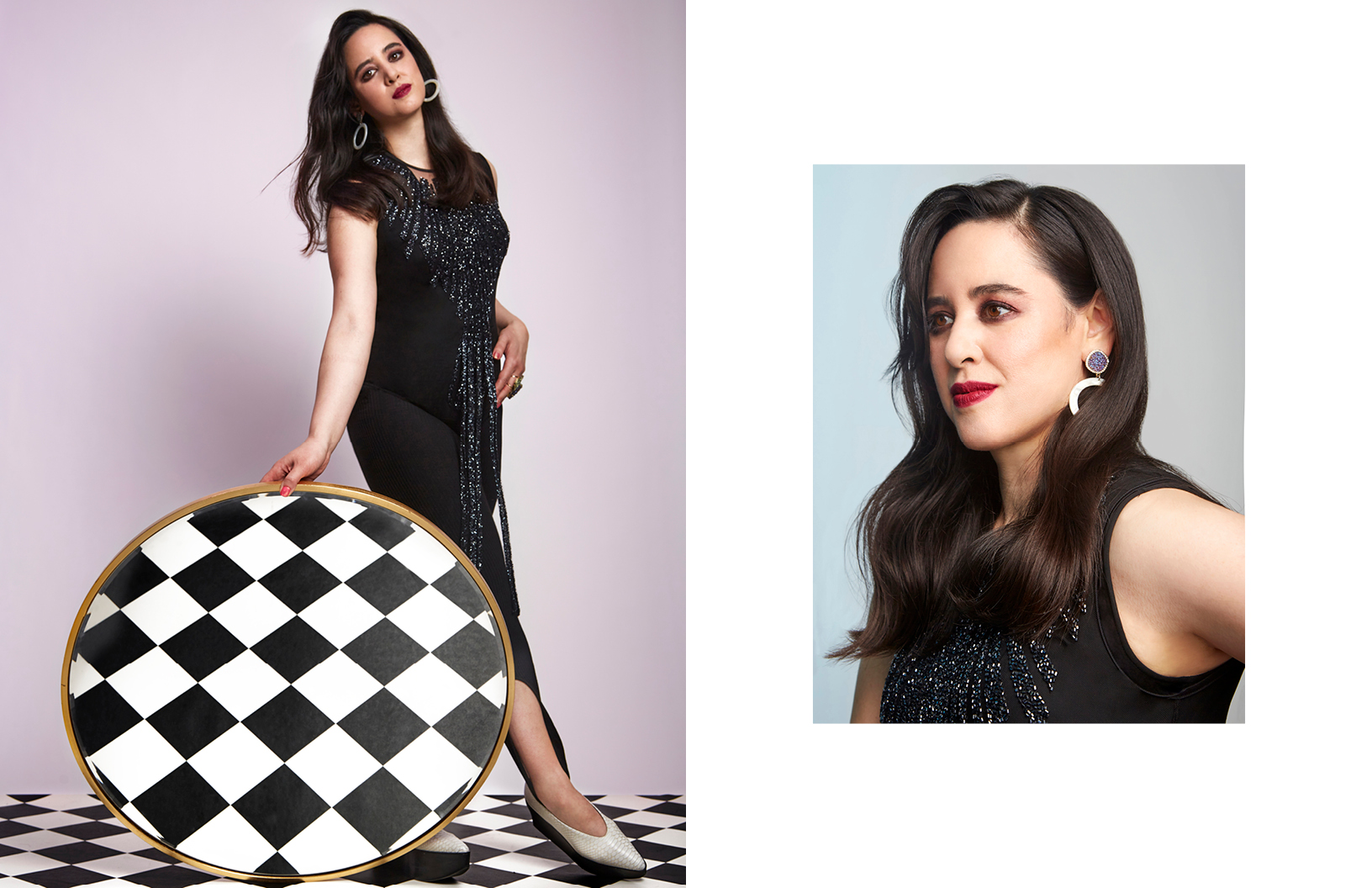
bodysuit. Agent Provocateur
top. Rebecca Taylor
leggings. Andrea Adamo
earrings. Baublebar
rings. Tiana Jewel, “Divine Love Oval
Rainbow Metallic Ring”, “Steffy Rainbow
Metallic Square Ring”, “Divine Love Tear
Drop Statement Rainbow Metallic Ring”,
“Divine Love Tear Drop Rainbow Metallic
Ring”
shoes. Stella McCartney
opposite
bodysuit. Agent Provocateur
top. Rebecca Taylor
leggings. Andrea Adamo
earrings. Baublebar
She also used the time to hone an early affinity with mixing high fashion and young, independent designers – creating looks as well as ‘calling in’ fashion to create a unique language: “Even as a student I’d pick up a copy of Vogue and either try and replicate a look by finding a similar item second-hand or in a charity shop or I’d make something myself, but I’d always prioritise fashion over buying anything else, and I firmly believed then, as I do now, in the value of wearing something incredibly special like a designer catsuit as part of the everyday.”
Travel, too, as a means of dipping into a rich variety of subcultures has informed her aspiration-oriented yet culturally eclectic outlook: “From my European base, I’d travel to Berlin or Ibiza, which were amazing for people watching. I’ve literally travelled all over the world to follow fashion; I see fashion as a total lifestyle.”
London life helped her corral a combined language of street style, the enchantingly frenetic idiosyncrasies of the club scene and theatrical accents perfectly in sync with the extravagant “jazz-ballet” sensibilities of her formative days in the talent academy. “For me, [London] was the land of creative entrepreneurs,” says Page.
An initial base in Shoreditch, east London, which is still home to many of the city’s freshest talents, introduced her to long-term friends and collaborators including Meesh Bryant, publishing director of the fiercely trendy mid-noughties magazine SuperSuper – a publication famous for its ‘more is more’, hyper positive, rave-inflected approach to art direction and graphic design – and Gareth Emmett and Rhys Dawney of alternative, gothic-infused streetwear brand Long Clothing, who also spearheaded the 2012 resurrection of the iconic club kid brand, Boy London. That same year Page was a finalist in a styling competition for Hunger magazine launched by the publication’s legendary founder, British fashion photographer Rankin. It cemented her future direction.
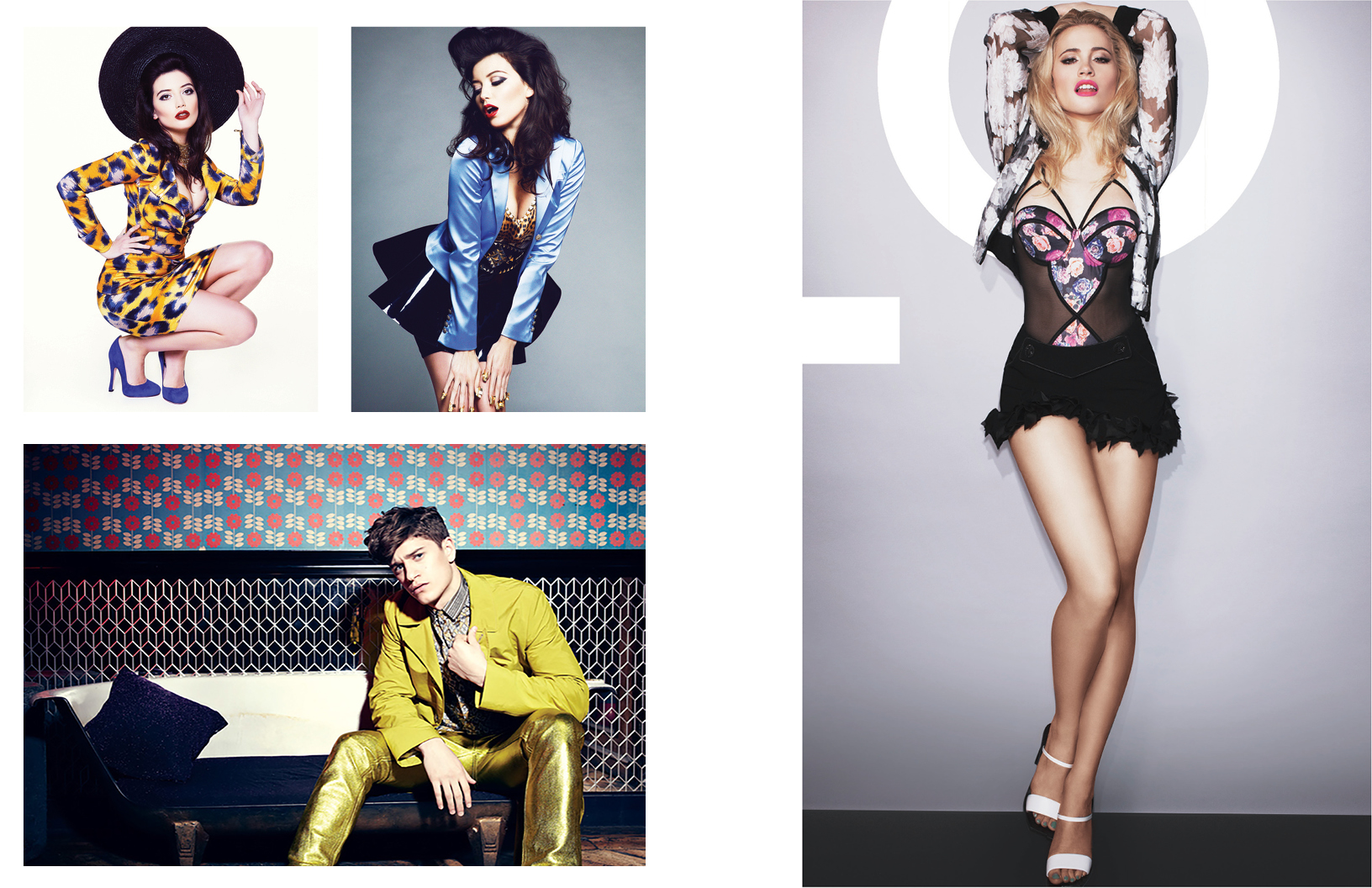
above
photography. Louie Banks @ FAULT magazine
fashion. Marika Page
model. Daisy Lowe
below
editorial. Welcome to the Funhouse
photography. Jen Endom @ Essential Homme magazine
fashion. Marika Page
Collaborations with photographers including LA-based Phil Knott – renowned for his work with artists including Kanye West, Kylie Minogue, ASAP Rocky and Katy Perry – and the music/fashion/film magazine Fault followed, offering an ideal platform for Page’s entertainment-centric vision of fashion; a sensibility inherently imbued with character creation on a slightly-more-epic-than-average scale (“I have always loved to deal in fantasy, but grounded in reality”). Key shoots with Fault include a 2013 story with hyper-successful British girl group Little Mix at the time of their ‘Hey, How you Doin?’ collaboration with American superstar Missy Elliot where Page referenced classic Elliot looks from the ‘90s including customised caps and beanies – at the time a far tougher street style vibe than the more cartoonish televisual concoctions the group was generally styled in. Additionally, English singer Pixie Lott appears in cover shoot in a mix of young labels such as a lace catsuit by PPQ (then a key brand for London’s Saturday night flash-trash club kids) and mega, although equally fun-inflected houses such as Kenzo and Moschino. There is always a sense of humour nestled among the bravado, underlined via a riot of colour and that distinctive penchant for excess.
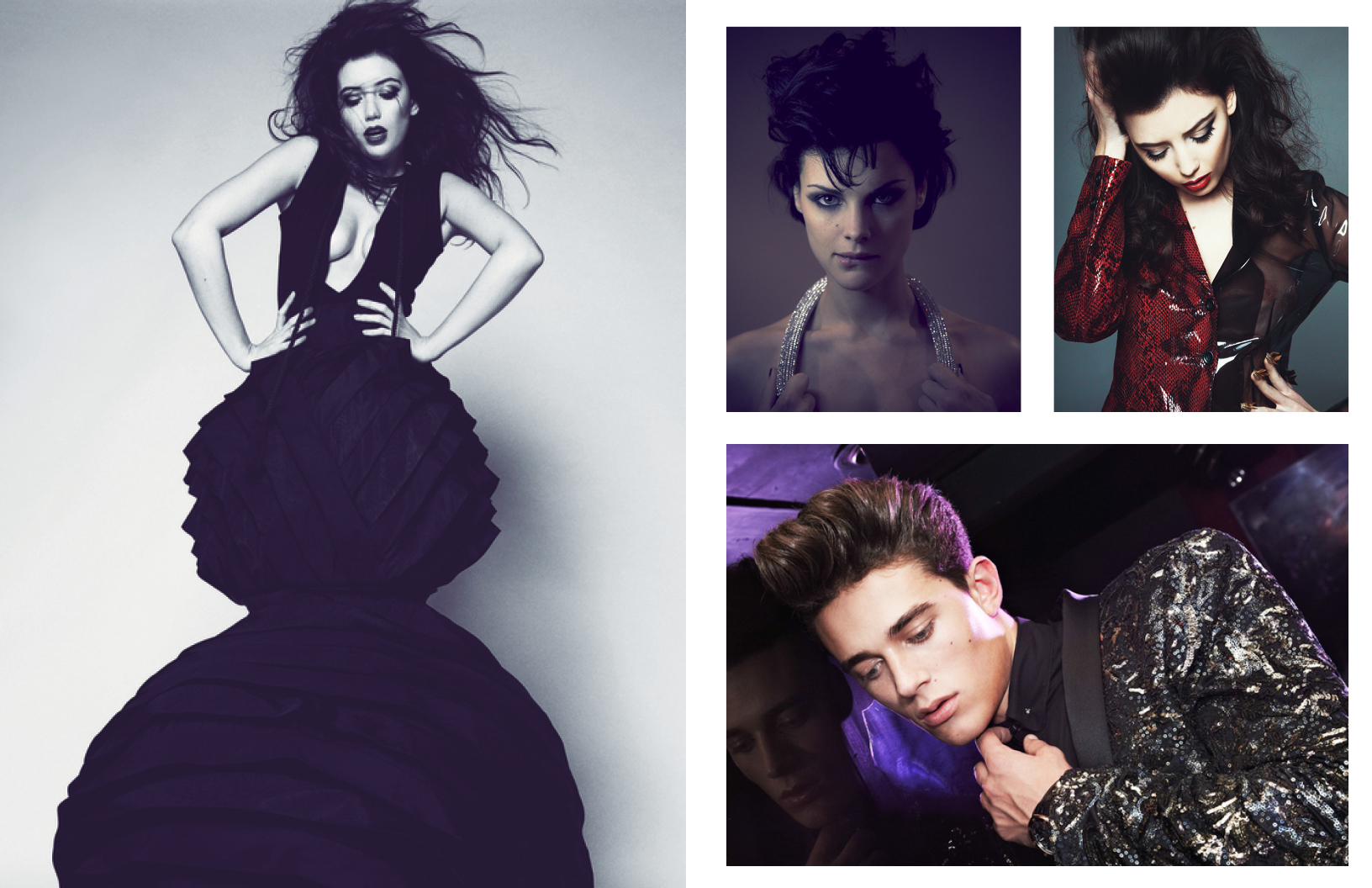
photography. Louie Banks @ FAULT magazine
fashion. Marika Page
model. Daisy Lowe
opposite
right
photography. Annick Wolfers @ FAULT magazine
fashion. Marika Page
model. Jaimie Alexander
left
photography. Louie Banks @ FAULT magazine
fashion. Marika Page
model. Daisy Lowe
below
editorial. Before Dawn
photography. Jen Endom @ Schön! digital
fashion. Marika Page
Subtle subversions of celebrity stereotyping (without veering into PR-terrifying territory) is something of a favourite past-time for Page. A shoot with the late TV presenter Caroline Flack depicts the tragic star not as the ultra-mainstream Love Island host of more predictable shoots but channelling a bohemian, end-of-the-summer festival sensibility that invokes a beautiful, ethereal fragility. Flack wears a 70s-inspired dress by British designer and sustainable materials innovator Jane Bowler constructed from recycled plastic alongside a series of decorative masks and headpieces. In another Fault cover shoot with Daisy Lowe – a British model largely pigeon-holed for her curvy figure – Page obliges the request to highlight those curves with the help of a dramatic piece of wearable sculpture by Serbian designer Ivana Pilja in a shoot that toyed with the typecasting, if not dismantling it altogether: “We wanted to go beyond the purely sexy girl to create something cooler – a look that wouldn’t undermine the artistry,” recalls Page. An additional story with pop star Sophie Ellis-Bextor, set in a location resembling the roaring twenties style decadence of the Orient-Express, sees the singer in a mix of vintage pieces by glam-supplying clubland entrepreneur Liz Mendez; garments from classic labels including Vivienne Westwood, Ossie Clarke London, milliner Philip Treacy; and special headpieces from Filipina designer Miche Dulce, who has worked on projects for avant garde music stars from Lady Gaga and Adam Ant to Italian super stylist Anna Della Russo.
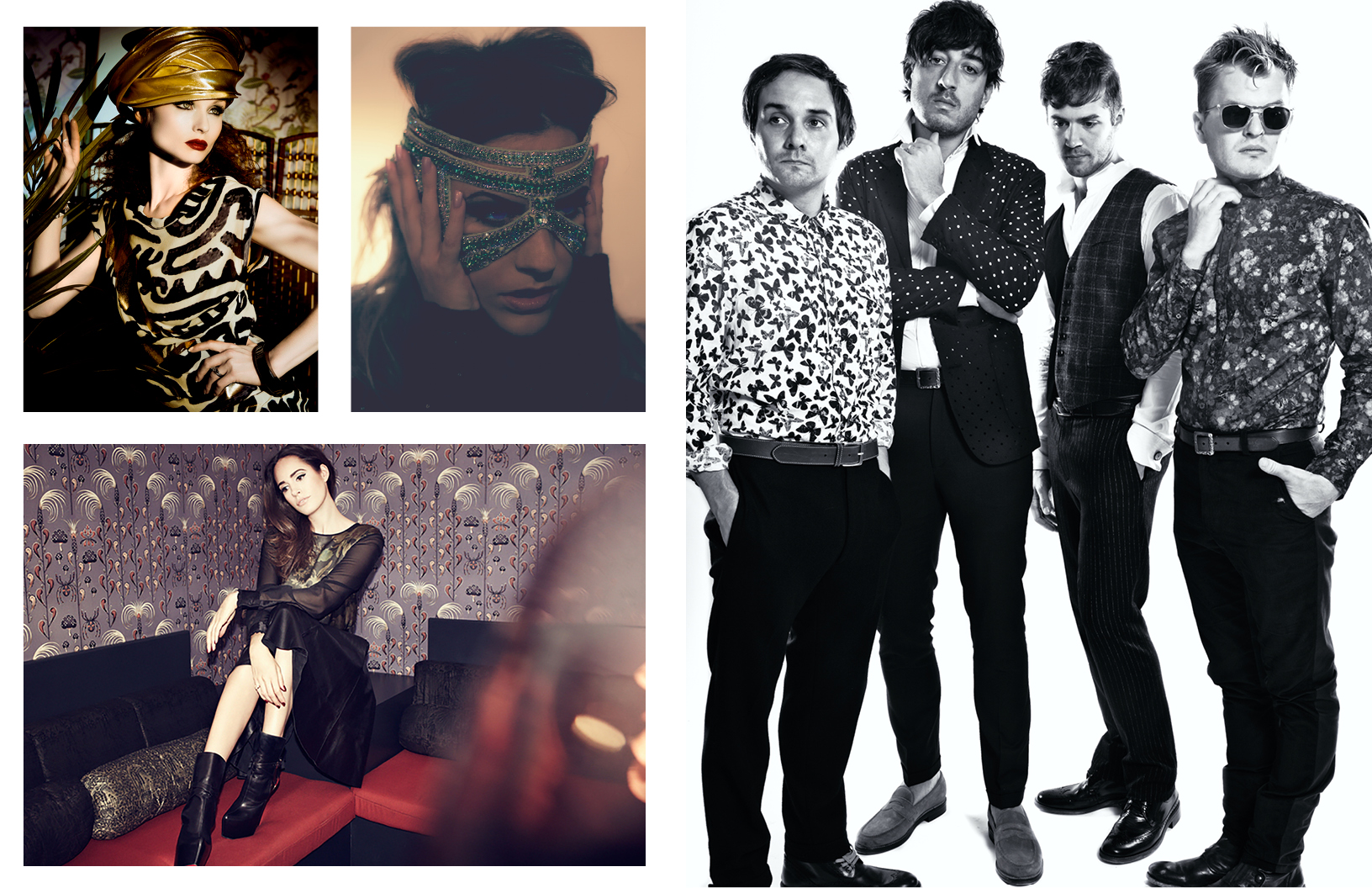
right
photography. Alice Luker @ FAULT magazine
fashion. Marika Page
model. Sophie Ellis-Bextor
left
photography. Annick Wolfers @ FAULT magazine
fashion. Marika Page
talent. Caroline Flack
below
photography. Jen Endom @ FAULT magazine
fashion. Marika Page
talent. Louise Roe
opposite
photography. Shunichi Oda @ FAULT magazine
fashion. Marika Page
talent. Grizzly Bear
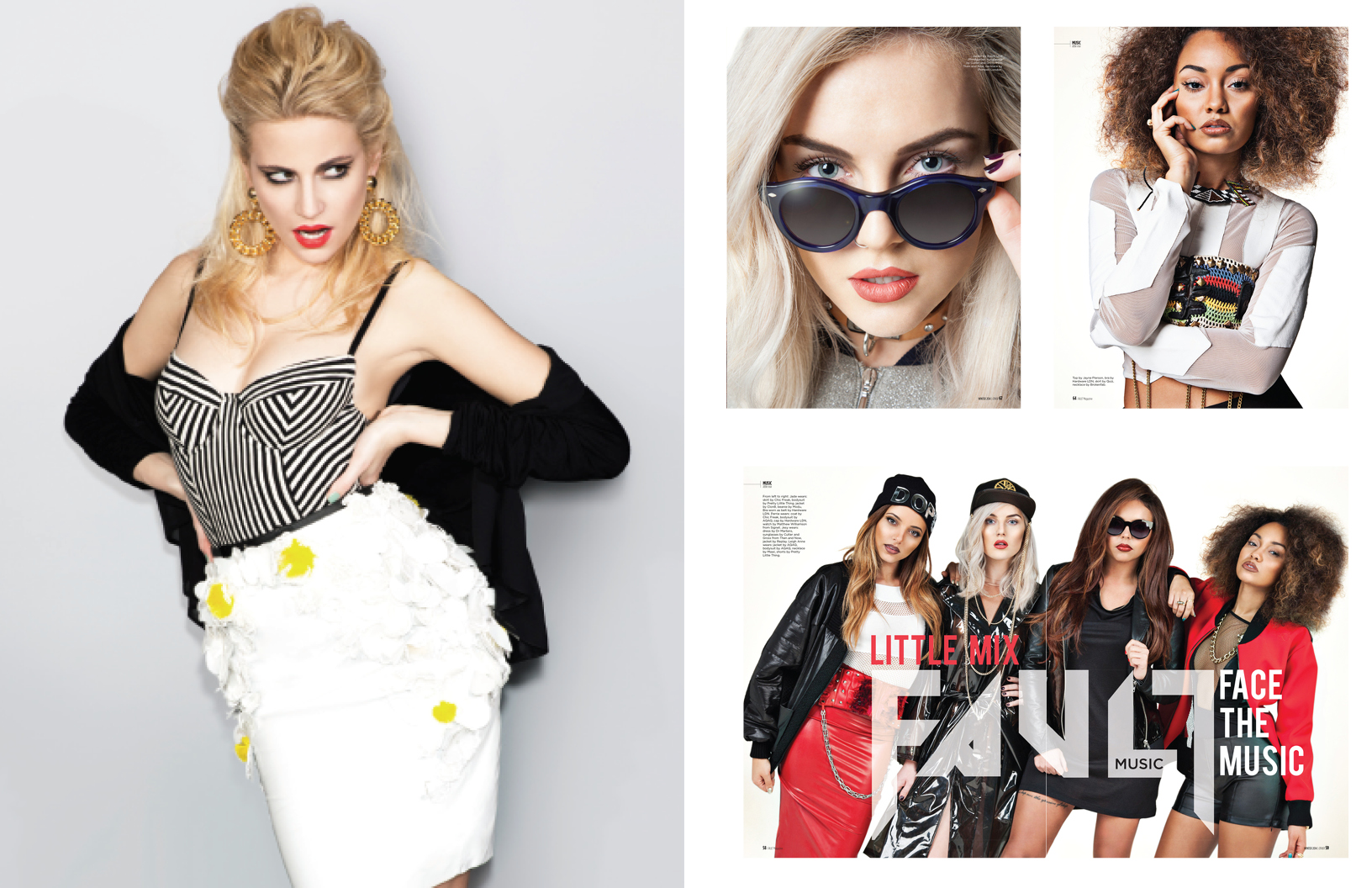
photography. Simon Harris @ FAULT magazine
fashion. Marika Page
model. Pixie Lott
opposite
left
photography. Benjamin Johnson @ FAULT magazine
fashion. Marika Page
talent. Perrie Edwards, Little Mix
right
photography. Benjamin Johnson @ FAULT magazine
fashion. Marika Page
talent. Leigh- Anne Pinnock, Little Mix
below
photography. Benjamin Johnson @ FAULT magazine
fashion. Marika Page
talent. 20-21. Little Mix
The same sense of borderline cinematic dynamism is visible in editorial shoots for magazines including Schön! Magazine and Hunger TV. There is a particularly beguiling black-and-white shoot called ‘A Handsome Woman’ for the latter (a colour-bereft anomaly for Page) shot by Shunichi Oda that’s centred on a glamorous androgyne – a femme fatale revelling in new collection and archive pieces by greats including Jean-Paul Gaultier and Ann Demeulemeester. It’s a key reminder that Page’s looks aren’t for wall-flowers, reflecting her belief in the importance of meeting a persona head on – willingly summoning a sense of bravado to deliver a true mindset shift. As she states: “I think that you need to intrigue and intimidate to create a really strong look.”
It’s a sense of reinvention she’s now deploying as frequently with private individuals as public-facing clients such as actors or pop stars, as the lines blur between traditional celebrity and influencers and the number of industry insiders that need to bolster their public persona rises. According to Page, accessing the empowerment of sartorial-clad artifice is the vital tool in owning that room: “Even if you’re not 100% comfortable it doesn’t matter because it’s not only about stepping into a persona but actually stepping up to it.”

Katie Baron is the author of Fashion + Music: Fashion Creatives Shaping Pop Music – “A celebratory exploration of how these twin agents of creative expression have long had a powerful mutual attraction, and of how fashion has consistently amplified our understanding of the band, and in many cases the brand”.
Marika Page currently works with artists seeking fashion styling and creative direction. Follow Marika Page on Instagram.
photography. Luke Hutson-Flynn
fashion, creative direction + production. Marika Page
talent. Marika Page
hair. Sam Burnett
make up. Louise Constad
video. Selda Yildirim Naumann
movement direction. Fraser Murray
music. ‘Alligator’ performed by Bonsai Mammal. Written by Jimmy Harry
fashion assistant. Amy Sweeney
location. Kimber Studio
words. Katie Baron


Schön! Magazine is now available in print at Amazon,
as ebook download + on any mobile device












